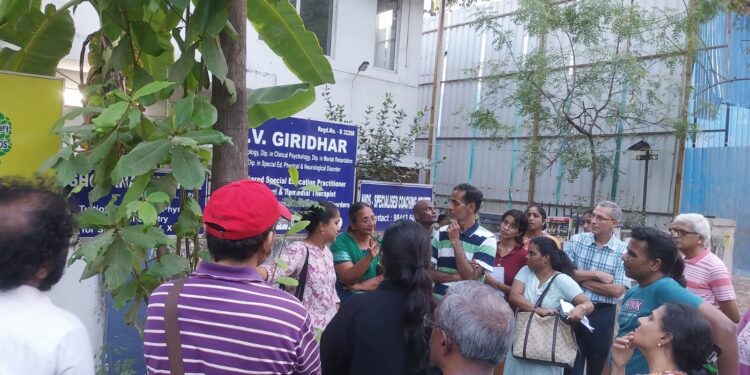By Krithika Hariharan
Celebrating Mother’s Day (May 12), NGO Nizhal organised a tree walk, as a tribute to mother nature. The walk, attended by over 50 people, featured the heritage trees of Gandhi Nagar 4th Main Road (B Ramachandra Adithanar Road).
Nizhal has planted numerous saplings across Gandhi Nagar roads. The tree walk aims to spark people’s curiosity about trees, educate them, and encourage them to care for them.
Divya, representing Nizhal, starts by telling a brief history about Gandhi Nagar, “Before this location was populated, there was a tropical dry evergreen forest here. Despite 10 months of dry weather and just two months of rain, the trees remain evergreen.”
1. Gulmohar (Delonix regia): Also known as Royal Poinciana, Flame Tree, or Fire Tree, it is an ancient ornamental tree grown in India. It is a non-native species that grows faster than indigenous trees but often lacks strong rooting, making it more prone to falling.
2. Monkeypod (Samanea saman): Popularly known as Rain Tree, it can grow up to 30 metres tall. It is commonly grown in Southeast Asia, particularly Singapore, because of its unique umbrella-shaped crown, which gives abundant shade. Since its leaflets fold up on sunny days (to prevent evaporation from leaves), gloomy days and in the early evening, it is also known as Pukul Lima – ‘five o’clock’ in Malay.
3. Indian Cork Tree (Millingtonia hortensis): It is a large, deciduous tree native to India and Sri Lanka. It typically grows to a height of 20 m and has large, heart-shaped leaves. It is found in moist, tropical forests and along river banks. It is grown as a decorative plant in parks and gardens as it provides a large shade, apart from its timber value. It is also used in traditional medicine.
4. Temple Tree: The sacred Temple tree, also known as Frangipani, is a species of flowering tree. The tree is sometimes called the spider tree because the showy flowers bear long, spidery stamens. It is native to much of tropical Asia and several South Pacific islands. In parts of Africa, it is grown for its fruits. It is a perennial tree that can grow up to 15 m. The nectar-filled flowers attract multitudes of insects and birds. A pierid butterfly, Hebomoia glaucippe, is a frequent visitor to this plant.
5. Punnai Tree (Pongam): Pongamia pinnata is a species of tree in the pea family, Fabaceae, native to eastern and tropical Asia, Australia, and the Pacific islands. It is the sole species in the genus Pongamia. Its common names include Indian Beech and Pongame Oiltree. Pongamia pinnata, a legume tree, grows to a height of 15-25 meters and has a broad canopy. It has a straight or crooked trunk of 50-80 cm in diameter with grey-brown bark. After 3-4 years, the tree blooms with fragrant white, purple, and pink flowers. Brown seed pods develop in 10 to 11 months and contain one or two seeds. Seeds can germinate only after the pods have decomposed.
6. Banaba: Also called the Queen’s crepe-myrtle, the Banaba plant, the pride of India, or ‘Queen’s Flower’, is a deciduous tree that grows in tropical southern Asia. The tree produces magnificent pink, purple, lilac, or pinkish-violet flowers that endure for several months. Its timber is highly valuable, ranking second only to teak in strength. It grows up to 15 m tall and has a lovely symmetrical crown and a short bole with smooth, flaky light grey or cream-coloured bark. The simple, deciduous leaves are oval to elliptic, about 8-15 cm long and 3-7 cm wide, with a sharp tip. The blooms are grouped in upright panicles.
Nizhal is a Kotturpuram-based NGO that is committed to preserving trees and greening the city. To get expert advice from Nizal or to volunteer with them, reach them at 98409 04621, 98841 14721, 94450 28067, 98414 49829; email: [email protected]; website: www.nizhaltn.org. Instagram: @Nizhalshade.
Trivia Time!
We present here some trivia as shared in the Walk:
- We can distinguish between simple and compound leaves when we see them on trees. Trees with simple leaves are those that have only one leaf per stem, such as those of mango trees, curry leaves, and neem leaves, while compound leaves branch out from the stem into smaller ones like that of Gulmohar, Tamarind (puliya maram), Persian Silk tree, etc.
- The way the trees have been named in English has a colonial connection. The British tried to identify the trees based on similar-looking trees back home. Thus many such trees will have ‘Indian’ in their names, eg. West Indian Elm (Rudraksha maram), Indian Beech (Pugam maram) and Indian Ash (Udayam maram).
- The Monkeypod tree branches, in Central America, are host to many unique insects that are attracted to its delicious sap water. As they continue to sip the sweet sap they tinkle excessively in and around the tree, thus giving it the name ‘Rain tree’ as people experience the drizzle under it.
- In India, we commonly name localities after the dominant trees of the locality. For example, Maruthamalai signifies the abundance of Marutha maram, Purasaivakkam had many Purasai maram, Panaiyur abounds with Panai maram. In earlier days, people used to be astute about naming locations as they wanted people to imagine a landscape that existed in the locality. However, it is not the same today.











